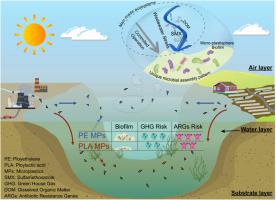当前位置:
X-MOL 学术
›
Water Res.
›
论文详情
Our official English website, www.x-mol.net, welcomes your feedback! (Note: you will need to create a separate account there.)
Combined environmental pressure induces unique assembly patterns of micro-plastisphere biofilm microbial communities in constructed wetlands
Water Research ( IF 11.4 ) Pub Date : 2024-06-17 , DOI: 10.1016/j.watres.2024.121958 Peihao Yan , Shuzhen Zhuang , Mingjun Li , Jian Zhang , Shubiao Wu , Huijun Xie , Haiming Wu
Water Research ( IF 11.4 ) Pub Date : 2024-06-17 , DOI: 10.1016/j.watres.2024.121958 Peihao Yan , Shuzhen Zhuang , Mingjun Li , Jian Zhang , Shubiao Wu , Huijun Xie , Haiming Wu

|
The characteristics and dynamics of micro-plastisphere biofilm on the surface of microplastics (MPs) within artificial ecosystems, such as constructed wetlands (CWs), remain unclear, despite these ecosystems’ potential to serve as sinks for MPs. This study investigates the dynamic evolution of micro-plastisphere biofilm in CWs, utilizing simulated wastewater containing sulfamethoxazole and humic acid, through physicochemical characterization and metagenomic analysis. Two different types of commercial plastics, including non-degradable polyethylene and degradable polylactic acid, were shredded into MPs and studied. The findings reveal that the types, shape and incubation time of MPs, along with humic acid content in wastewater, affected the quantity and quality of biofilms, such as the biofilm composition, spatial structure and microbial communities. After just 15 days into incubation, numerous microbials were observed on MP samples, with increases in biofilms content and enhanced humification of extracellular polymeric substances over time. Additionally, microbial communities on polylactic acid MPs, or those incubated for longer time, exhibit higher diversity, connectivity and stability, along with reduced vulnerability. Conversely, biofilms on polyethylene MPs were thicker, with higher potential for greenhouse gas emission and increased risk of antibiotic resistance genes. The addition of humic acid demonstrated opposite effects on biofilms across environmental interfaces, possibly due to its dual potential to produce light-induced free radicals and serve as a carbon source. Binning analysis further uncovered a unique assembly pattern of nutrients cycle genes and antibiotic resistance genes, significantly correlated within micro-plastisphere microbial communities, under the combined stress of nutrition and sulfamethoxazole. These results emphasize the shaping of micro-plastisphere biofilm characteristics by unique environmental conditions in artificial ecosystems, and the need to understand how DOM and other pollutants covary with MP pollution.
中文翻译:

综合环境压力导致人工湿地中微塑料球生物膜微生物群落的独特组装模式
尽管人工生态系统(例如人工湿地(CW))内的微塑料(MP)表面上的微塑料球生物膜的特征和动态仍不清楚,尽管这些生态系统有潜力充当塑料微粒的汇。本研究利用含有磺胺甲恶唑和腐殖酸的模拟废水,通过物理化学表征和宏基因组分析,研究了化学武器中微塑料球生物膜的动态演化。将两种不同类型的商用塑料(包括不可降解的聚乙烯和可降解的聚乳酸)粉碎成 MP 并进行研究。研究结果表明,MP的类型、形状和培养时间以及废水中的腐殖酸含量影响生物膜的数量和质量,例如生物膜的组成、空间结构和微生物群落。孵化仅 15 天后,就在 MP 样品上观察到大量微生物,随着时间的推移,生物膜含量增加,细胞外聚合物的腐殖化增强。此外,聚乳酸 MP 上的微生物群落或培养时间较长的微生物群落表现出更高的多样性、连通性和稳定性,同时脆弱性也降低。相反,聚乙烯 MP 上的生物膜更厚,温室气体排放的可能性更大,抗生素抗性基因的风险也更高。添加腐殖酸对跨环境界面的生物膜表现出相反的影响,这可能是由于其产生光诱导自由基和作为碳源的双重潜力。 分箱分析进一步揭示了营养循环基因和抗生素抗性基因的独特组装模式,在营养和磺胺甲恶唑的联合胁迫下,它们在微塑料球微生物群落中显着相关。这些结果强调了人工生态系统中独特的环境条件对微塑料球生物膜特性的塑造,以及了解 DOM 和其他污染物如何与 MP 污染共变的必要性。
更新日期:2024-06-17
中文翻译:

综合环境压力导致人工湿地中微塑料球生物膜微生物群落的独特组装模式
尽管人工生态系统(例如人工湿地(CW))内的微塑料(MP)表面上的微塑料球生物膜的特征和动态仍不清楚,尽管这些生态系统有潜力充当塑料微粒的汇。本研究利用含有磺胺甲恶唑和腐殖酸的模拟废水,通过物理化学表征和宏基因组分析,研究了化学武器中微塑料球生物膜的动态演化。将两种不同类型的商用塑料(包括不可降解的聚乙烯和可降解的聚乳酸)粉碎成 MP 并进行研究。研究结果表明,MP的类型、形状和培养时间以及废水中的腐殖酸含量影响生物膜的数量和质量,例如生物膜的组成、空间结构和微生物群落。孵化仅 15 天后,就在 MP 样品上观察到大量微生物,随着时间的推移,生物膜含量增加,细胞外聚合物的腐殖化增强。此外,聚乳酸 MP 上的微生物群落或培养时间较长的微生物群落表现出更高的多样性、连通性和稳定性,同时脆弱性也降低。相反,聚乙烯 MP 上的生物膜更厚,温室气体排放的可能性更大,抗生素抗性基因的风险也更高。添加腐殖酸对跨环境界面的生物膜表现出相反的影响,这可能是由于其产生光诱导自由基和作为碳源的双重潜力。 分箱分析进一步揭示了营养循环基因和抗生素抗性基因的独特组装模式,在营养和磺胺甲恶唑的联合胁迫下,它们在微塑料球微生物群落中显着相关。这些结果强调了人工生态系统中独特的环境条件对微塑料球生物膜特性的塑造,以及了解 DOM 和其他污染物如何与 MP 污染共变的必要性。











































 京公网安备 11010802027423号
京公网安备 11010802027423号